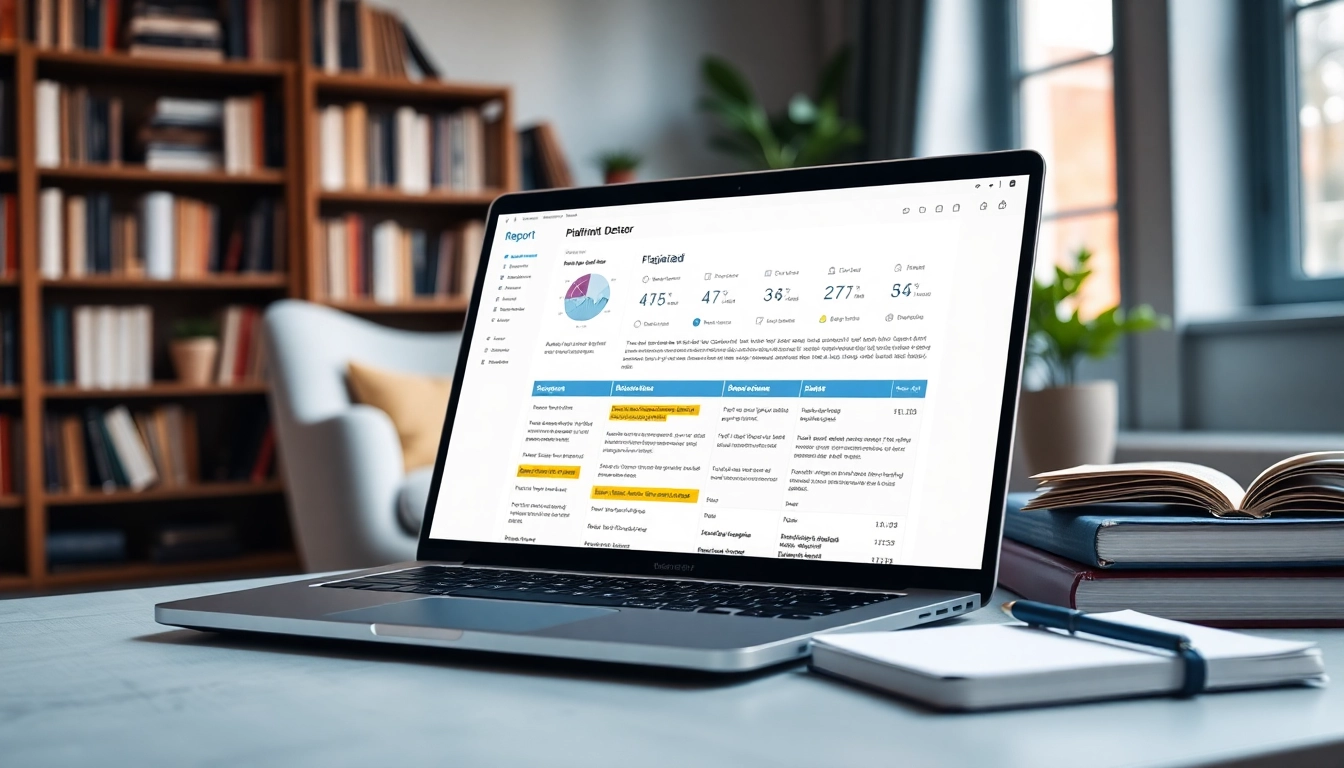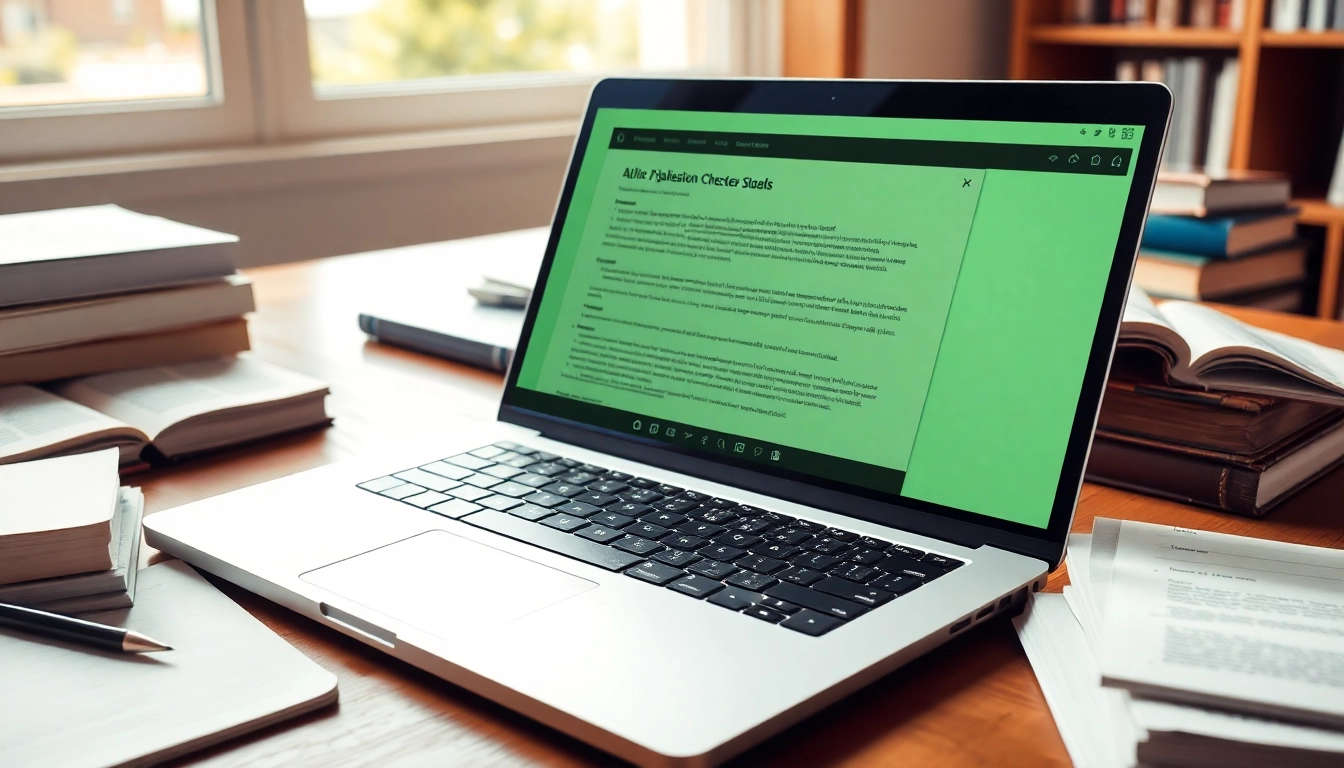Understanding Plagiarism Detectors
What is a Plagiarism Detector?
A plagiarism detector is a sophisticated tool designed to identify instances of plagiarism in texts. This can encompass a variety of content, including academic papers, articles, essays, and even creative works. Essentially, plagiarism detectors compare a submitted text against a vast database of existing works to find similarities, enabling users to verify the originality of their writing. The goal is to uphold academic integrity, prevent copyright infringement, and support proper attribution practices. These detectors are crucial in educational institutions, businesses, and content creation fields, where original content is paramount.
How Plagiarism Detection Works
The functionality of plagiarism detectors can broadly be categorized into three main processes: text comparison, algorithm utilization, and reporting. After the user inputs text into the detector, the tool scans the text through various databases, looking for text matches. This includes online content, academic articles, journals, and other submissions. Using algorithms, the detector evaluates not just direct matches but also paraphrasing, contextual similarities, and even references, providing a comprehensive analysis of potential plagiarism.
Most plagiarism detection tools employ advanced algorithms that may leverage artificial intelligence (AI) to improve accuracy. These algorithms can analyze phrasing, syntax, and the overall structure of sentences to identify reworded or translated content that still holds the original idea.
Benefits of Using a Plagiarism Detector
Utilizing a plagiarism detector offers numerous advantages, including:
- Academic Integrity: Maintaining originality and proper citation in scholarly work.
- Improved Writing: Detectors not only find plagiarism but assist in enhancing writing skills by suggesting ways to paraphrase effectively.
- Time-Efficiency: Quickly checking large documents saves time compared to manual scans.
- Confidence Boost: Enabling writers to submit work with assurance that it is original.
- Cost-Effective: Many detectors, including free versions, allow access to essential plagiarism checking features without significant investment.
Popular Plagiarism Detection Tools
Comparative Analysis of Top Tools
In the competitive market for plagiarism detection, several tools stand out for their features, accuracy, and user experience. Here’s a comparative analysis of some popular tools:
1. Grammarly
Grammarly, known for its grammar-checking capabilities, also offers a plagiarism detection feature. It scans millions of web pages and academic content to ensure the submission’s originality. Grammarly’s user-friendly interface makes it popular among students and professionals alike.
2. Turnitin
Widely recognized in academic institutions, Turnitin provides an in-depth plagiarism detection solution. It not only checks for similarities but also assesses writing quality and originality, making it a preferred choice for educators seeking comprehensive evaluations.
3. Duplichecker
Offering a no-cost alternative, Duplichecker allows users to copy and paste text for immediate results. While the free version has limitations on word count, it remains a valuable resource for quick checks by casual users.
4. Copyleaks
Copyleaks uses AI technology to detect plagiarism in multiple languages and formats. Its capability to identify paraphrased content adds an extra layer of security for creators, making it a reliable choice for professionals.
Free vs. Paid Plagiarism Detectors
The market is saturated with both free and paid plagiarism detectors. Free tools are advantageous for students or occasional users due to their accessibility, but they often come with limitations in terms of word count, database coverage, and features. Paid tools, on the other hand, provide comprehensive checks, more sophisticated algorithms, and detailed reporting that cater to professionals and institutions. Users should assess their needs against the tool features to decide which type best suits their requirements.
User Reviews and Feedback
User feedback plays a crucial role in determining the effectiveness of plagiarism detection tools. Users frequently mention the importance of accuracy in identifying similarities and providing clear reports. Tools like Turnitin and Grammarly receive high praise for their reliability and integration capabilities, whereas some free tools are criticized for their limited database and result comprehensiveness. Before choosing a plagiarism detector, it’s advisable to check recent user reviews and testimonials to gauge performance and satisfaction.
Best Practices for Using Plagiarism Detectors
How to Prepare Text for Analysis
Effective preparation of text before using a plagiarism detector can significantly enhance the accuracy of the results. Key strategies include:
- Clear Formatting: Remove unnecessary formatting and ensure that the text is in a simple format to prevent potential scanning errors.
- Segment Large Texts: For lengthy documents, break the text into smaller sections to facilitate more thorough checks and avoid hitting any word count limits imposed by some detectors.
- Consistent Language: Ensure the text is written in the same language to avoid confusion during checks that may not cater to multilingual content.
Interpreting Results Effectively
Once the analysis is complete, understanding the results is vital. Most detectors provide a similarity score indicating the percentage of matched content. Users should not only focus on this number but also examine the highlighted sections to understand the nature of the matches:
- Direct Matches: Text that is identical to existing sources.
- Paraphrased Content: Content that has been rewritten but retains the original meaning.
- Properly Cited Work: Ensure that any quotes or citations are correctly attributed and not flagged as plagiarism.
Avoiding Common Pitfalls
While plagiarism detectors are valuable, users can encounter pitfalls if not used correctly:
- Overreliance on Technology: Users should still apply critical thinking and editing skills to supplement the technology.
- Ignoring Context: Not all matches indicate plagiarism. Understand the context and usage of phrases in academic writing.
- Single-Scan Dependency: Conduct multiple checks across different detectors for comprehensive assessments since each tool has its own database and capabilities.
Plagiarism Policies in Education
Importance of Academic Integrity
Academic integrity is the foundation of educational excellence. Institutions emphasize the necessity for students to produce original work to truly reflect their understanding and capabilities. Plagiarism not only undermines this integrity but also can lead to severe consequences, including academic penalties, damage to reputations, and a loss of trust within educational settings.
Implementing Plagiarism Detectors in Schools
Educational institutions have begun to adopt plagiarism detectors as part of their curriculum to promote academic honesty. Implementation can involve:
- Integrating Tools into Coursework: Incorporating plagiarism detection as a part of the assignment submissions process helps instill the importance of originality from an early stage.
- Training for Both Educators and Students: Offering workshops or resources on how to effectively use plagiarism detectors enhances understanding and applicability.
- Creating Clear Policies: Educational websites should include detailed policies on academic honesty and the role of plagiarism detectors in promoting it.
Case Studies on Plagiarism Management
To better understand the impact of plagiarism management through the use of detectors, several institutions have implemented comprehensive systems to track and reduce instances of academic dishonesty. For example, a case study involving a large university revealed a 30% reduction in reported plagiarism incidents when students were educated on plagiarism detection tools and held accountable for their work.
Another example involved the introduction of mandatory plagiarism checks before submission for all thesis papers. This proactive approach led to higher awareness and adherence to academic integrity standards among students.
Future of Plagiarism Detection Technology
Emerging Trends in Detection Methods
The evolution of technology, particularly artificial intelligence and machine learning, is set to redefine how plagiarism is detected. Automated content analysis will allow for more sophisticated recognition, even capturing nuances in writing styles. Additionally, the use of cross-referencing with digital footprints and improving database accessibility will further enhance the detection capabilities of future tools.
The Role of AI in Plagiarism Detection
Artificial intelligence is increasingly proving essential in refining plagiarism detection tools. Utilizing AI allows for:
- Contextual Analysis: Identifying whether instances are true plagiarism or legitimate academic references.
- Adaptive Learning: Tools can learn from new data points, improving their detection accuracy over time.
- Language Processing: AI can evaluate different languages effectively, making detectors more comprehensive.
Anticipating Changes in Academic Policies
As plagiarism detection tools become more sophisticated, academic institutions may adapt their policies regarding original content submission. We anticipate that future standards will emphasize training for critical thinking, proper citation practices, and continuous learning about ethical writing. These adaptions will likely reduce the need for punitive action in favour of educational approaches to plagiarism management.
In conclusion, the use of a plagiarism detector is an essential practice in today’s academic and professional landscapes. From understanding its purpose to leveraging its full potential, these tools are vital in nurturing a culture of originality and integrity in all forms of writing.



